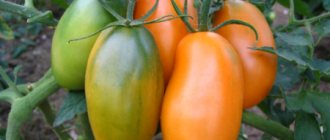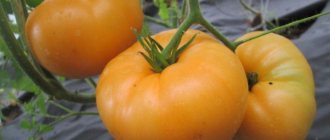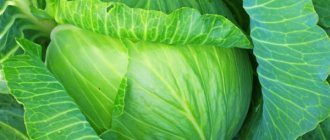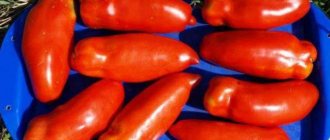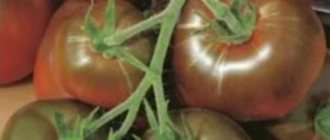Tomato Orange Russian 117, despite the name “Russian”, was created in the USA. However, in our area it also grows well and pleases gardeners with large, beautiful, and most importantly, tasty fruits.
| Height | Landing location | Ripening time | Fruit color | Fruit size | Origin | Fruit shape |
| Tall | Greenhouse, Open ground | Mid-season | Bicolor | Large | Variety | Heart-shaped |
Description of the variety
This variety can be classified as bicolor tomatoes, in which there are two colors. The structure of the bush itself is quite weighty, which allows tomatoes to grow at a distance from each other, which gives them the opportunity to grow large and in large quantities.
This is interesting! This variety is tall and does not have an approximate indication of arrested development. Its height can reach up to two meters.
- The variety can be classified as a standard variety, which will not develop normally unless several stems are formed.
- The leaves on the bushes are not numerous and the bush grows practically not covered with them.
- The leaves are very beautiful, openwork with a rich green color.
Growing
- Planting is carried out taking into account the future planting of seedlings in the ground.
- The soil must be dug up and fertilized.
- For better fruiting of the bushes, the soil after replanting is well loosened, which allows air to circulate freely. This planting will provide reliable protection against many diseases.
- If weather conditions are not ideal for planting developed and formed seedlings, there is no need to hesitate. Seedlings tend to outgrow and are more difficult to transplant. Over time, it weakens and becomes unable to bear enough fruit.
- Gardeners should temporarily transfer the plant to a greenhouse or plant tomatoes with temporary cover in the form of a film in the open ground, which is left at night for additional protection.
- It is good to hill up such a tomato. This will help him cope with unfavorable external factors and develop well.
Advantages of the variety
Compared to other tall varieties, Orange Russian 117 has a lot of advantages:
- average fruit weight is three hundred grams,
- fruits of an interesting shape with pointed tips, while oval,
- interesting color of the fruits outside and inside: the skin is red with wide orange stripes, the tips are crimson, the pulp also has a heterogeneous color when cut,
- there are practically no seeds in tomatoes and in cross-section they are dense, “meaty”,
- the pulp of the fruit is popularly called sugar pulp,
- the skin of the tomato is dense and therefore is not damaged during transportation,
- This variety has a shelf life of about one and a half months if maintained at a certain temperature.
Landing
You need to know some nuances in order to get healthy seedlings from the Orange Russian 117 tomato: characteristics and description of the variety, real reviews, photos from the plantings of gardeners who planted the grown seedlings. Seeds are planted 55 days before planting in open ground. Deep planting of plants and systematic hilling of beds with tomatoes will give greater yield.
Tomatoes definitely need to be picked. Usually the middle root is pinched. After planting seedlings in the ground, the plants should be tied up. After the flowers ripen, the variety needs stepsoning: 2 stepsons are left, located below the first fertile cluster. This helps the rapid formation of fresh shoots. Further stepsoning is carried out as they appear.
Note! If you feed tomatoes with mineral complexes and constantly keep the soil moist, the plants will be strong and the yield will increase.
Maturation
The fruits are formed after the 110th day. The countdown begins from when the seeds sprouted.
Advice: in order for the bushes to bear a lot of fruit, they should be formed into several stems. And to stop the growth of the plant, you need to pinch it from above. When the growth of the bush stops, the plant will spend all its energy on its fruits.
Advantages and disadvantages of the variety
Many gardeners are interested in how to note the main advantages of the Orange Russian 117 tomato variety. Of course, following the basic rules of agricultural technology increases the chances of successfully growing vegetables.
The main advantages of the Orange Russian 117 variety:
- optimal harvest, because you can harvest up to 3-4 kilograms with proper care of tomatoes;
- orange tomatoes are distinguished by dense and juicy pulp and an almost complete absence of seeds;
- pleasant taste characteristics guarantee the possibility of successful use of tomatoes;
- the decorative quality of ripened fruits and their resistance to transportation make it possible to grow tomatoes even for sale in small quantities;
- long-term storage, which guarantees the opportunity to enjoy the harvest even after several months.
The above advantages determine the popularity of tomatoes of the Orange Russian 117 variety. Disadvantages are practically excluded, but gardeners must follow all the rules of agricultural technology to eliminate the risk of tomatoes withering if the basic rules of growing vegetables are violated.
Disease Prevention
This tomato variety loves aphids and whiteflies. To destroy them, insecticides and tinctures of bitter herbs mixed with soap are used.
If the bush is sick, be sure to remove it from the garden bed and spill the soil with a solution of manganese and iodine-containing preparations.
To prevent late blight, treat the plantings at the moment the fruits ripen with Bordeaux mixture or a special product - phytosporin.
Those who once gave preference to Orange Russian 117 tomatoes: their characteristics and description of the variety, informative reviews, interesting photos of vegetable growers who planted tomatoes of this type are not just amateurs, but professionals in their field. The excellent quality of tomatoes makes it possible to decorate the table in winter with preparations made from processed products.
Description and characteristics of the variety
Fact! Orange Russian 117 is an indeterminate tomato of medium ripening. Many gardeners note the delicate appearance of the tomato bush, because the powerful stems are covered with numerous thin leaves. Proper care allows a tomato bush to grow up to 150-200 centimeters, but for a successful harvest it is advisable to form only a couple of stems.
The Orange Russian 117 tomato variety is ideal for growing in greenhouses and open ground, and the yield rate always promises to be quite high. Gardeners usually harvest up to 3-4.5 kilograms of tasty, medium-sized tomatoes with dense, delicious pulp. The harvest is best harvested after about 3.5-4 months.
Reviews from experienced gardeners
Ilya Nikolaevich 65 years old, Balashikha:
“I planted this variety for the first time a couple of years ago in my greenhouse. I liked that the tomato pulp was juicy and sweetish. The taste is reminiscent of some tropical fruit. There are very few seeds and they are small. My family and I reaped a large harvest, as one bush bore up to three kilograms of fruit. Next year I’ll delight my grandchildren with fresh tomatoes of this variety again.”
Irina 43 years old, Krasnodar:
“I have little experience in growing tomatoes, since this is only the second year I’ve owned the garden. Neighbors advised us to take seedlings of this particular variety. They said that the fruits are similar to the “ox heart” variety, which I simply adore. I planted the seedlings, immediately watered the beds, and tied up the stems. I didn’t think that the bushes grow more than one and a half meters. I had to re-bandage it three times over the summer. The fruits are extremely beautiful and colorful. The sellers did not deceive, the flesh is really dense and sweet.”
Reviews
Pauline:
“Orange Russian 117 is my favorite variety of orange and juicy tomatoes. Easy cultivation guarantees a decent harvest in the shortest possible time. Even a novice gardener will be able to cope with growing the Orange Russian 117 tomato and be convinced of the existing advantages.”
Inna:
“I really love different orange tomatoes. Moreover, I have been growing the Orange Russian 117 variety for 3 years in a row. This tomato always pleases with a rich and very tasty harvest.”
Vladimir:
“I really love working on my garden, although it is small in size. I always carefully choose varieties of vegetables. Last summer I grew Orange Russian 117 tomatoes and was pleased with my harvest. I plan to grow it this coming summer as well.”
Measures to help increase the number of fruits
In order for tomatoes of this variety to grow and fill better, it is recommended to carry out the following activities:
- regularly loosen the soil around the bushes, trying to be careful not to damage the root system; remove weeds of any size;
- treat with special preparations against various viruses and pests for preventive purposes;
- Water the tomatoes regularly, abundantly and in a timely manner, which will allow them to grow better;
- Before planting each plant, it is necessary to drive a peg next to the hole, to which the bush will then be tied, this will help prevent the risk of damage to the roots;
- it is necessary to shoot the plants, leaving 1-2 stems on the bush, while the number of brushes should vary from 4 to 5;
- to significantly increase the number of fruits, get rid of the first flowers;
- fruits are collected as they ripen, and then according to the results of actual ripeness;
- To get more yield, you need to attract insects to the bush.
To attract insects, you can use a solution of sugar and water. Take 2 tablespoons of sugar per liter of water. The substance is carefully sprayed throughout the planting area.
You should know! If you form a bush with 1 stem, then you need to cut off the shoots from the sides, leaving only the central one. If a two-stem bush is formed, then, in addition to the main one, you should leave another shoot, which is located under the first flower cluster.
The best varieties of tomatoes with descriptions
Each tomato variety has its own personality. Behind each are years of work by breeders and decades of popular selection. The beauty of the best modern tomato varieties is their diversity. So we “exploit” tomato hybrids and varieties with unlimited growth - indeterminate, semi-determinate, and determinate, the average height of which for the most part ranges from 70-80 cm, and low-growing vegetables, whose height does not exceed half a meter (all of them We will discuss the differences and features in the article below).
You cannot give advice based on outside experience, as some do, deliberately introducing not entirely truthful information about the yield (quantity and quality) of grown tomatoes. They say here they are - the best varieties of tomatoes of the past (and, further, in descending numbers) for tomatoes of the year. With everything, however, it should be noted that they often focus on plant varieties proposed for planting for open and closed ground, without understanding that the advice will be good only after personal experience - better after at least 3-4 years (honestly, but extremely rarely , and 2 are sometimes enough) and with meticulous experiments (starting with growing seedlings using the soil additive Vermiculite, the growth stimulator Gumi and, ending with fertilizing: magnesium sulfate, mineral fertilizer Fertika-Kemira and so on - already in the garden) for each variety.
Why am I giving such a deadline? Yes, because you definitely need to take into account the weather, which differs from year to year, and this is the minimum, in my opinion, period to have more or less an idea about each variety of tomatoes.
Our technology for growing tomatoes of different varieties is as follows. On our plot we allocate 6 long rows for tomatoes (including closed soil). On three of them, representatives of the best varieties of tomatoes, proven over the years, are grown (there are also tomatoes to choose from), guaranteeing a harvest according to the declared characteristics (regardless of the “delights” of the weather), and the other three are planted with new varieties, which are “considered” this way and that in during the above time. That seems to be it.
PS To make life easier for readers and reduce the time it takes to absorb the article, instead of determining the yield of vegetables in kg per 1 square meter, it will be written below - kg “per square”.
And now I am announcing the number of tomatoes tested in growing, presented below for your viewing, which can still be called the best - 60 varieties.
PS The results were recorded in an area that: with a good warm season, corresponds to the Central Black Earth region (region), and with a bad warm season, corresponds to the North-Western region. Naturally, this range of latitudes in which the above regions are located definitely includes Siberia, the Moscow region, the Middle Zone, the Urals, the Far East, and then figure out for yourself where exactly the paths lead to your site.
Before you accurately choose a variety or hybrid of tomatoes, you need to decide where exactly they will grow.
For open ground, low-growing varieties that will ripen early are more suitable. Mid-ripening species in good summer weather can produce a fairly good harvest, but they are susceptible to microflora, which can destroy most fruits.
It is customary to grow tall varieties and various hybrids in greenhouses. Here you can plant absolutely any tomatoes, even late-ripening ones.
The most problem-free tomatoes are super-determinate ones, in which the main stem ends its growth at a height of no more than half a meter. Among these tomatoes there are ultra-early, early and mid-early. Some don't even need to be tied up. Bushes are not pruned at all, except up to the first cluster - for an even earlier harvest.
Super grade
Previously, the tomato was released as Super Pepper, but changed its name for registration in the registry (2007). A favorite ground variety of many amateur gardeners. This can be done any year, regardless of the weather. In terms of timing, medium early. In seedlings, super-compact, stocky, does not stretch. In the ground it grows as a strong bush with close internodes.
The plant's clusters are planted through the leaf; the number of fruits we grow is somewhat less than stated - 4-6. The first tomatoes are especially large, reaching 275 g, and look flattened and heart-shaped. The following clusters grow pepper-shaped, 130-200 g each. The color is raspberry-pink. The pulp is fleshy, sugary, almost without seeds, like the best salad varieties. This variety is also good for pickling. But the fruits cannot be called shelf-stable.
Tomato Demidov
Deservedly popular
A popular, reliable ground variety, known far beyond the borders of Siberia and Altai, spreading throughout the country, including the Far East. Medium early in terms of ripening (108-114 days). The flower raceme appears after the 6th or 7th leaf. When working with these standard bushes, we refuse to take stepson, due to their small branching.
Suitable for thickened planting (they risked 5 pieces per 1 square, producing a bucketful harvest from this area). The tomatoes are round, sometimes slightly ribbed. Weight 80-160 g. Color raspberry-pink; The green spot on the stalk does not immediately color. Dense pulp of excellent taste. The only whim of the variety is the need for uniform soil moisture, without sudden changes, otherwise the fruits may begin to burst. Picked unripe, the tomatoes ripen perfectly when stored.
Mysterious
A time-tested variety, on the register since 2004. It has both devoted supporters and opponents: it is difficult to say whether it is the quality of the seeds or the microclimate. In a successful local version, the variety is very abundant (up to two buckets per square), disease-free, compact from the very shoots. Standard bush. Vegetable shedding is minimal.
Medium early variety. The first inflorescence of the plant is formed after the 9th leaf. The fruits in the lower cluster reach 13-14 cm and weigh 270-330 g. The subsequent ones weigh 80-150 g. All of them, shaped like peppers, are rich red in color, fleshy, and have a harmonious taste. Recommended for small farms, gardens and personal plots.
Special
Breeders work a lot with the old folk variety Grushovka, using its genetic material for updated variants. Seed companies offer Grushovka, Moscow Grushovka, hybrid F1 Grushovka pink (Aelita). Non-hybrid Grushovka pink from the Siberian company Agros, registered in the register in 2013, has not a pear-shaped, but an oval shape.
Tomato Metelitsa
Early
The variety is zoned in the Urals and Siberia, in the register since 2005. This is an updated version of the old variety Siberian early ripening. An early, uniformly ripening salad variety, without pinching. The first brush grows after the 7th leaf. The fruits are round, sometimes ribbed, weighing 60-120 g, bright scarlet with an orange tint, quite dense for an early variety.
The yield per bush is approximately 2 kg.
Tomato Lazy
Early large
The newest early-ripening variety of vegetables (95 days from germination to ripening). But it still needs additional verification of the breeding promises. The sweet, heart-shaped fruits are very beautiful, with an average weight of 300 g; in the lower clusters they are twice as large. In order not to lose the first cluster, you need to plant seedlings in the garden at the age of 40 (in theory 45) days, no more.
Consequently, sowing too early is also not necessary; they can lead to a shortage of crops and delays. We make sure to plant the bushes up to the first tassel, and then give them freedom to branch. With this formation, it is possible to remove two buckets of tomatoes from 1 square, which is almost incredible for a low-growing variety.
Tomato Klusha
Hides the fruits
The variety has been on the state register since 2009. In terms of ripening time (108-114 days) it is close to mid-early. Plants are standard, compact in seedlings and in the ground. The Klusha tomato variety is determinate; the height of its bushes usually does not exceed 60 cm. The plants are planted at a close distance to each other. Growing without pinching is allowed.
To get a decent return from the area, we plant 5 pieces per square. Fruit clusters are covered with leaves on top. Fruits weighing 100-150 g, pure red. The shape is round, slightly flattened, slightly ribbed. The taste is good, the purpose is universal. The variety is characterized by high yield and resistance to the main pests of nightshade crops.
Tomato Superklusha
Small bush, big harvest
The year of entry into the register is 2015. The height of the bush is on average only 35 (plus or minus 2) cm. It never stretches in seedlings. In the soil it grows compactly, the roots also do not “scatter”. We plant 6 pieces per square. This allows you to get up to one and a half buckets of fruit from such an area, most of which ripen on the vine.
Tomato Gigolo
Original form
The bush is densely hung with bright red tomatoes - “sausages” about 14 cm long and weighing 130 g. Pulp without water, solid “meat”. When pickled, it is not inferior in density to cucumbers. We do not grow standard bushes with a height of about 40 cm. Each fruit cluster contains 5, sometimes 6 “sausages”. Ripening is widespread, medium-early (100 days).
Description of the Orange tomato variety, its characteristics and yield
Some gardeners do not recognize any tomato varieties other than red ones. For those who do not adhere to these stereotypes, the Orange tomato is suitable for several reasons. Firstly, it is unpretentious, secondly, the orange color of the vegetable and many other positive properties.
Variety criteria
Why the characteristics and description of the variety are needed, every summer resident knows. This information allows you to advantageously place the bushes on the site and properly care for them.
Plant:
- Superdeterminant.
- It belongs to the mid-season varieties, as it ripens in 100-115 days.
- Bush height 80 cm.
Tomato:
- Orange color.
- Round shape.
- Weighing 90-150 g.
- The taste is sweet, slightly sour.
- Density is average.
- Due to the thick skin, they tolerate transportation well, maintaining their presentation.
A variety of this variety is another type of tomato that is in demand among summer residents: Big Orange. It is distinguished by the indeterminate structure of the bush, early ripening, fruit weight up to 250 g, and a total yield per 1 m2 of 20 kg.
Planting seeds
Experienced summer residents advise growing tomatoes in seedlings, as there is a possibility of receiving fruits ahead of schedule. Seeds should be sown in advance, 60 days before transferring to a permanent place. Each gardener independently calculates the days when to start sowing, since the regional climate is different.
Land for seedlings is prepared in advance or purchased in stores. Its composition is as follows:
- 1 part of turf land;
- 1 part sand;
- 2 parts humus;
- some wood ash and sawdust.
Seeds purchased in specialized stores from trusted manufacturers do not need processing. It is recommended to immerse your planting material in a 3% solution of potassium permanganate for several hours.
Small seedlings need sunlight, 16 hours a day, air temperature from +20-22 ⁰С. Fertilizing is carried out 21 days after emergence. Use complex fertilizers or growth stimulants.
Transfer to the ground
The summer resident has no less trouble during the period of transfer to a permanent place. It is necessary to apply fertilizers and prepare the area for the beds. Humus and wood ash are added to the holes. Plants are watered and transplanted into them.
It is better not to water the tomatoes for the first few days, this will prevent rot from occurring.
There are 6 plants per 1 m2; they should not interfere with each other. Remove weeds in a timely manner, as they prevent tomatoes from developing properly and, in addition, are carriers of diseases and pests.
Loosening and hilling will provide oxygen access to the roots and retain moisture in the soil. Water tomatoes as needed in the evening. The water used is warm.
Feeding tomatoes at least 3 times:
- 14 days after transplantation.
- During the flowering period.
- During the period of fruit set and formation.
The plant does not need shaping. The bushes are not very spreading, no garter is needed, the strong stem itself can support the weight of the fruit.
Use in everyday life. Productivity
Use orange tomatoes everywhere. Added to salads, cooked dishes, used for pickling and canning. A special feature of the variety is the presence of beta-carotene in the fruit. Therefore, vegetables are used in dietary nutrition.
If all requirements are met, agricultural technicians receive up to 6.5 kg of tomatoes per 1 m2.
Plant immunity
An important criterion for choosing a variety is susceptibility to disease. The resistance of tomatoes to the disease makes the variety popular among others.
F1 Orange tomatoes resist:
- Alternaria.
- Tobacco mosaic.
For other diseases, preventive treatment is recommended. Using chemicals before flowering, and traditional methods after.
What do summer residents say about Orange tomatoes?
An excellent assistant for a beginning gardener are reviews from those who have already grown the variety on their site. In addition to their own opinions, some vegetable growers give specific advice on care and cultivation.
Vasily: “An excellent variety, good yield. Unpretentious and disease-resistant plants.”
Marina: “I’ve been growing it for 2 years in a row. The taste is excellent, the size of the vegetable is suitable for any method of consumption.”
Tomato varieties have many beneficial properties, one of them is the presence of a special compound that is suitable for dietary nutrition.
What about the yellow-fruited tomato? Amana orange variety and its description
Ripe and large tomato fruits that ripen in the garden beds are a source of pride for any gardener. But sometimes you really want variety! Moreover, today there are enough different varieties of unusual shapes and colors. One of the most notable is Amana Orange. Hurry up and get acquainted with its description, maybe it will be the one that will show off in your garden this season!
Description of the variety
The Amana Orange tomato is a tall variety, its powerful medium-leafed bushes reach almost 2 m. It is not surprising that it has large fruits, because this tomato was bred in the USA, where they like everything to be bigger and bigger. This happy event happened back in the 90s of the 20th century, and interest in the variety has not subsided to this day.
The tomato is intended for greenhouses, but in the southern regions it also grows well in open ground. The weight of the fruit varies from 300 to 700 g. According to some reviews, in ideal conditions they can reach 1 kg!
Attention! The variety is considered one of the best among yellow-fruited tomatoes. It is very productive: up to 18 kg of tomatoes can be harvested from 1 m²
They are used both fresh and processed.
Amana Orange tomato of medium early ripening. It stores well and is quite resistant to late blight and other tomato diseases.
| Mid-early | Indeterminant | Salad | For greenhouses | 300-700g | from 16 to 18 kg/m² | Orange | Flat-round, slightly ribbed |
Advantages and disadvantages
Amana Orange tomatoes have a number of advantages:
- The main thing is the wonderful taste of the fruit. They are sweet, almost without seeds, very sugary, fleshy.
- They store and transport well and do not crack - which is rare for yellow-fruited varieties.
- Tomatoes are resistant to diseases, especially late blight. Read about other varieties resistant to this disease here.
- It bears fruit even in cold and rainy summers.
There are few disadvantages of the variety, but in fairness we need to talk about them:
- Does not accept cultivation in open ground. In this case, there are few fruits, their taste deteriorates and their sizes are very small.
- They cannot tolerate sudden changes in temperature.
- The first fruits are large, the subsequent ones are much smaller.
Features of agricultural technology
Tomato seedlings are planted in February. For this reason, additional lighting is necessary. They are sent to the greenhouse 60 days after germination. To achieve maximum results, frequent fertilizing with special fertilizers for tomatoes is required (about once every 2 weeks).
It is necessary to form 1-2 stems; pinching must be carried out on time! We described exactly how to plant tomato bushes in this article. The bushes need a garter to a support or trellis. The first cluster of inflorescences appears under the 9th leaf, and then every 3 leaves. You can harvest tomatoes 40-45 days after planting the seedlings.
Diseases and pests
The main enemy for Orange from Russia, according to all reviews, may be the Colorado potato beetle, which is difficult to fight without suitable pesticides. Collecting pests by hand is ineffective when their numbers are too large. Gardeners must closely monitor the first signs of the development of a particular disease in order to stop it in time and take care of the normal development of the crop.
Sometimes it is enough to add additional liquid fertilizer, which can prevent the spread and harmful effects of pathogens in the early stages. Liquid fertilizer is what to use if plants have yellowing lower leaves, or a purple tinge on the undersides.
Liquid fertilizers deliver nutrients to tomatoes much faster than dry fertilizers. The instructions on the packaging must be strictly followed. A large amount of fertilizer is burned by the tomato plant. In most cases, add a few tablespoons of emulsion to water, which is applied to the soil near the plant.
